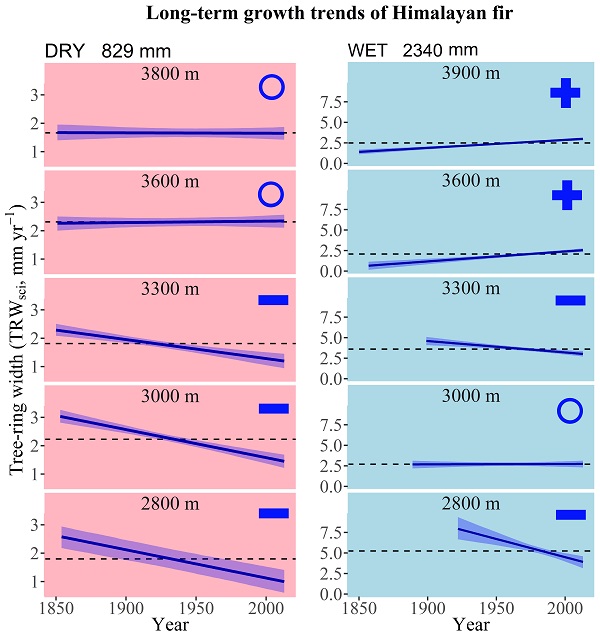Himalayan forests, with Abies spectabilis (Himalayan fir) as one of the dominant tree species, are often characterized by strong environmental gradients (temperature and rainfall). They present unique opportunities to study the interactive effects of climate and atmospheric changes on tree growth. However, dendroecological studies of Himalayan montane forests along elevation gradients are scant, and were all restricted to reporting growth-climate response in a specific region.
In a new study published in Global Change Biology, researchers from Xishuangbanna Tropical Botanical Garden (XTBG) and their collaborators conducted a comprehensive study on long-term physiological and growth responses to environmental changes of Himalayan fir by using dendroecology and tree-ring stable carbon-isotope analysis in the central Himalaya, Nepal.
The researchers sampled Himalayan fir in a wet and dry region, to understand how mean climatic conditions (temperature, rainfall) drive climate-growth relations, physiological trends (intrinsic water use efficiency) and long term growth trends.
They found that long-term physiological and growth responses of Himalayan fir to multiple environmental changes are mediated by the mean climatic conditions. Thus, intrinsic water-use efficiency (iWUE) has increased during the past century across elevations and in both dry and wet regions, with stronger responses in dry region.
Furthermore, tree radial growth was reduced in years with higher (spring) temperature and increased in years with higher precipitation and moisture availability in the dry region, while (summer) temperature had a positive effect in the wet region.
They also found that long-term negative growth trends at at low to middle elevations in both dry and wet regions, although trend in tree-growth is positive at high elevations in the wet region. Warming has favored tree-growth at higher elevations in wet region, however positive effects of CO2 rise through photosynthesis and water relations (both reducing source limitation) did not mitigate the negative effects of warming and drying on tree growth at low to middle elevations in both dry and wet regions.
“Our results contribute to a better understanding of the physiological and growth responses of high-elevation forests to climatic and atmospheric changes. The decreasing growth trends at low to middle elevations raise concerns on the productivity and dynamics of Himalayan fir forests as climate change progresses,” said Prof. FAN Ze-Xin, principal investigator of the study.
Contact
FAN Zexin Ph.D Principal Investigator
Key Laboratory of Tropical Forest Ecology, Xishuangbanna Tropical Botanical Garden, Chinese Academy of Sciences, Mengla, Yunnan 666303, China
E-mail: fanzexin@xtbg.org.cn
Long-term trends of tree-ring widths (TRWsci, corrected by size-class isolations) of Himalayan fir in dry and wet regions and at five elevational belts in each region in the central Himalaya.
(Image by FAN Zexin)

